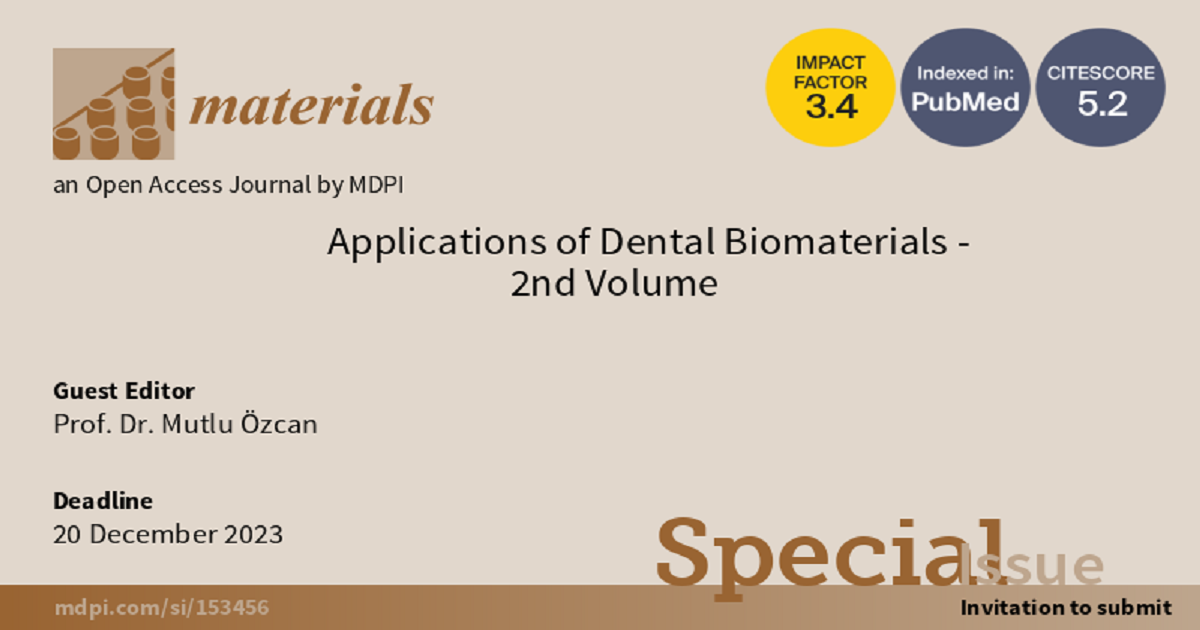- 3.2Impact Factor
- 6.4CiteScore
- 16 daysTime to First Decision
Applications of Dental Biomaterials - 2nd Volume
This special issue belongs to the section “Biomaterials“.
Special Issue Information
Dear Colleagues,
Advances in the fields of biomaterials, biomedical engineering, and new technologies continue to have a huge impact on patient care in almost all disciplines of dentistry. The Special Issue “Applications of Dental Biomaterials - 2nd Volume” in the journal Materials (IF: 3.748) welcomes high-quality original research and review articles in the arena of dentistry. The particular focus of submissions should encompass translational and clinical studies related to applied science from prevention aspects to reconstruction of intraoral or craniofacial defects, missing teeth or dental tissues where biomaterials are used. This Special Issue will provide information on the dynamic changes and challenges taking place at the interface of biomaterials and technologies, aiming at improving dental treatment options and dental care.
Prof. Dr. Mutlu Özcan
Guest Editor
Manuscript Submission Information
Manuscripts should be submitted online at www.mdpi.com by registering and logging in to this website. Once you are registered, click here to go to the submission form. Manuscripts can be submitted until the deadline. All submissions that pass pre-check are peer-reviewed. Accepted papers will be published continuously in the journal (as soon as accepted) and will be listed together on the special issue website. Research articles, review articles as well as short communications are invited. For planned papers, a title and short abstract (about 250 words) can be sent to the Editorial Office for assessment.
Submitted manuscripts should not have been published previously, nor be under consideration for publication elsewhere (except conference proceedings papers). All manuscripts are thoroughly refereed through a single-blind peer-review process. A guide for authors and other relevant information for submission of manuscripts is available on the Instructions for Authors page. Materials is an international peer-reviewed open access semimonthly journal published by MDPI.
Please visit the Instructions for Authors page before submitting a manuscript. The Article Processing Charge (APC) for publication in this open access journal is 2600 CHF (Swiss Francs). Submitted papers should be well formatted and use good English. Authors may use MDPI's English editing service prior to publication or during author revisions.
Keywords
- dental biomaterials
- preventive dentistry
- reconstructive dentistry
- adhesive dentistry
- digital dentistry
- implantology

Benefits of Publishing in a Special Issue
- Ease of navigation: Grouping papers by topic helps scholars navigate broad scope journals more efficiently.
- Greater discoverability: Special Issues support the reach and impact of scientific research. Articles in Special Issues are more discoverable and cited more frequently.
- Expansion of research network: Special Issues facilitate connections among authors, fostering scientific collaborations.
- External promotion: Articles in Special Issues are often promoted through the journal's social media, increasing their visibility.
- e-Book format: Special Issues with more than 10 articles can be published as dedicated e-books, ensuring wide and rapid dissemination.
Related Special Issues
- Applications of Dental BiomaterialsinMaterials (26 articles)

